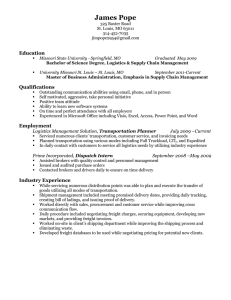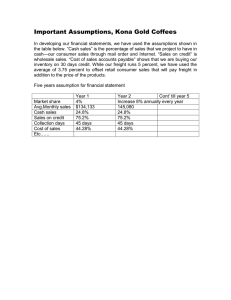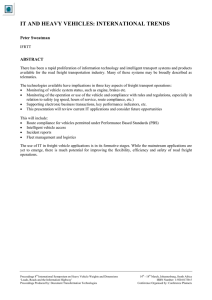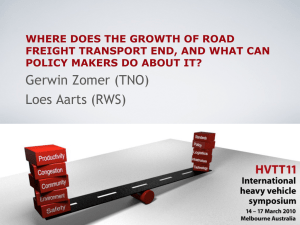Urban Freight Transport, Logistics and ITS Dr Russell G. Thompson
advertisement
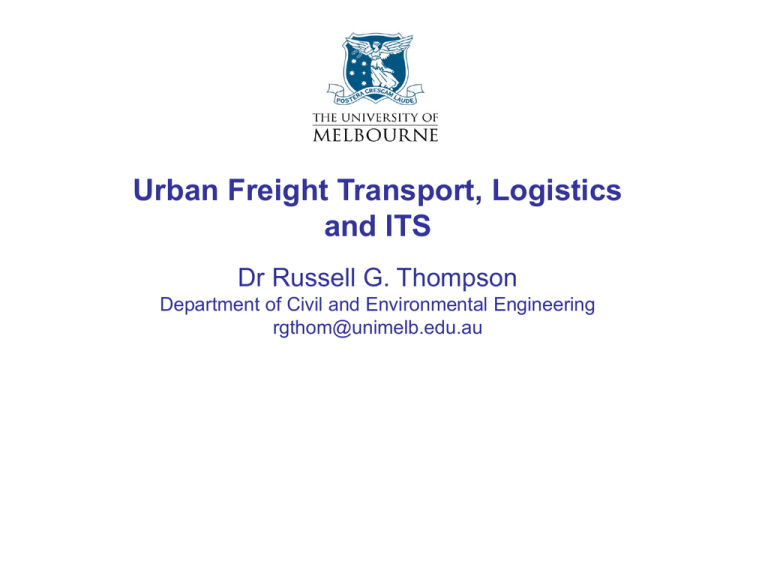
Urban Freight Transport, Logistics and ITS Dr Russell G. Thompson Department of Civil and Environmental Engineering rgthom@unimelb.edu.au Outline Sustainability Intelligent Freight Systems City Logistics Urban consolidation centres e-Commerce (B2C) Product Swaps Container Management Co-opetition Next Generation Urban Freight Infrastructure “We do not inherit the earth from our ancestors; we borrow it from our children” from a Mexican Poster (M.R. Reuter, 2003) Sustainable Cities Freight systems affect the economic prosperity & liveability of cities Prosperity and liveability are related Both are vital for sustainability Urban Freight Problems • • • • • • • Noise Emissions (Particulates & GHG) Congestion Crashes Vibration Energy consumption Visual intrusion ITS can reduce these problems by reducing the amount of truck travel in cities… Intelligence • Analysing - sensing & analysing environment - detecting changes, perceiving problems • Making decisions - acting rationally, choosing options to solve problems • Learning - using experience to make improvements: identifying new problems & decision making Intelligent Freight Systems Those that are: Clever - successful in copy with new situations & solving problems Alert - fast in perceiving & understanding problems & finding answers to challenges ITS key elements • Intelligence - gaining knowledge (data collection & information processing) • Integration – connecting & co-ordinating key elements Urban Freight Is a derived demand Primary drivers are from processes associated with management of inventory such as manufacturing & retailing City Logistics City Logistics is an integrated approach for urban goods distribution based on the systems approach. It promotes innovative schemes that reduce the total cost (including economic, social and environmental) of goods movement within cities OECD, (2003) Delivering the Goods, Challenges for the 21st Century, Paris. City Logistics City Logistics is an integrated approach for urban goods distribution based on the systems approach. It promotes innovative schemes that reduce the total cost (including economic, social and environmental) of goods movement within cities OECD, (2003) Delivering the Goods, Challenges for the 21st Century, Paris. City Logistics is the process for totally optimising the logistics and transport activities by private companies with the support of advanced information systems in urban areas considering the traffic environment, its congestion, safety and energy savings within the framework of a market economy Taniguchi, Thompson & Yamada, 2001 City Logistics Schemes Public Logistics Terminals Co-operative Freight Systems Access Regulations Advanced Vehicle Routing & Scheduling Systems (CVRSS) Intelligent Transport Systems are crucial for these schemes to be successfully implemented… Sustainability Mobility Global competitiveness Efficiency Environment friendliness Congestion alleviation Security Structure of visions for city logistics Safety Energy conservation Labour force Liveability Institute for City Logistics Est. 1999 Aim: to promote City Logistics esp. modelling, evaluation & data collection Activities • International Conferences 6th Int. Conf. June 2008 in Puerto Vallarta • Workshops • Newsletters • Collaborative Research www.citylogistics.org Multiple UCC Kolher & Groke, 2004 1 UCC with Pick-up Points (Kassel) Kolher & Groke, 2004 ITS to support Urban Consolidation Centres & Co-operative Freight Systems Dynamic & integrated Order Processing Vehicle Routing & Scheduling Load Planning Transhipment Track & Trace Eg. Centre for Eco-Friendly Distribution, Lucca, Italy (Di Bugno et al, 5th Int. City Logistics Conference, Crete, 2007) B2C Food Items Household Characteristics Density Population Trip Frequency Load Area Customers Home Deliveries Market Share Shop Sales Delivery Fleet Characteristics Distribution Fleet Characteristics VRS Deliveries VRS Distribution Time Windows Distance Travelled Single Urban DC DC low density medium density stores Regional DC’s VKT with 1 distribution centre Suppliers to distribution centre Distribution to stores Stores and homes (customers) Deliveries to homes Total Increase (%) Internet 0% 481.1 458.5 24037 0 24977 Sales 5% 481.1 458.5 22835.3 2805.9 26580.9 6.4 10% 481.1 426.9 21633 6346.2 28888 15.7 VKT with regional distribution centres Suppliers to distribution centre Distribution to stores Stores and homes (customers) Deliveries to homes from RDC’s Distribution to RDC’s from MDC Total Change (%) Internet Sales 0% 5% 481.1 481.1 458.5 458.5 24037 22835.3 0 1077.1 0 214.8 24977 25066.8 0.4 10% 481.1 426.9 21633 1841.5 214.8 24598 -1.5 Product Swaps Distribute 500kg between each site Vehicle capacity = 2000kg Each site ≥ 1 vehicle Transhipment possible at each site Based on distributing electrical goods between retail shops in Melbourne Concept could be applied to multiple carriers, horizontal collaboration (Fischer et al, 1995) 2 3 4 1 5 4 5 vehicles no transhipment 2 3 4 1 5 4 4 vehicles pickups at store w/o vehicle 2 3 4 1 5 4 4 vehicles with transhipment at stores 2 3 4 1 5 4 4 vehicles with transhipment at common location Distance Travelled (km) Network Analysis 600 500 400 300 200 100 0 5 veh. 4 veh. Good Configuation 4 veh. Opt 4 veh. Trans ITS for Product Swaps • Determining nodes for swaps • Coordinating arrivals and departures of vehicles • Load planning • Determining nodes that vehicles need to visit Cycle of Container Handling Loaded Container (Import) Marine Terminal & Container Park Empty pick-up Local Importer Empty Running Local Exporter Empty return Loaded Container (Export) Port Container Park Exporter Importer Current Container Movements Port Exporter Importer Movements with Triangulation Co-opetition Sharing vehicles, warehouses & distribution centres Increase load factors & decrease dead running All schemes require ITS for successful implementation Collaborative Distribution • Shared storage location(s) • Networks restructured using advanced vehicle routing & scheduling systems • Distribution to outlets by areas & priority • Substantial savings in transport costs (2030%) • Significant reduction in environmental & social costs Next Generation Urban Freight Infrastructure Intelligent Freight Systems using ITS – – – – – Vehicle routing & scheduling systems Auction systems (portals) Information Systems (eg. travel time & reliability) Track &Trace Systems Monitoring (eg. AVL) Necessary to support Public Logistics Terminals & Intermodal Freight Terminals Common information platform in PublicPrivate Partnerships Administrators VICS Traffic management server Traffic management server Decision making system Decision making system VICS Real time traffic information Freight carriers Freight information Company A Freight management Server Company B Freight management Server Company C Freight management Server Decision making system Decision making system Decision making system Other Initiatives • • • • • In-vehicle systems Advanced vehicle routing & scheduling e-Commerce Auction and matching systems Compliance monitoring systems Urban Freight Transport, Logistics and ITS Dr Russell G. Thompson Department of Civil and Environmental Engineering rgthom@unimelb.edu.au
